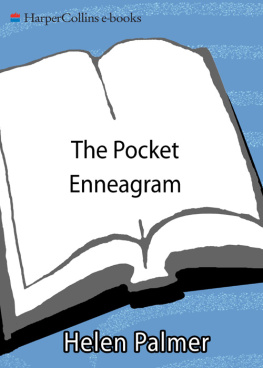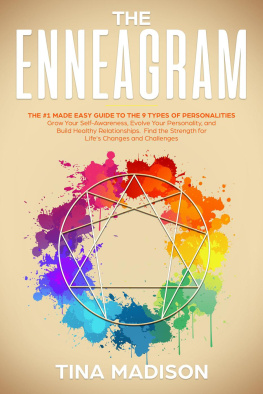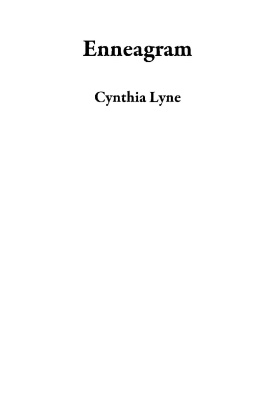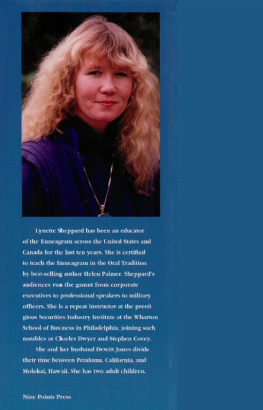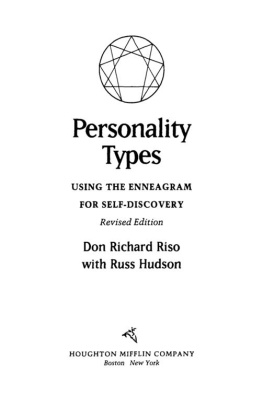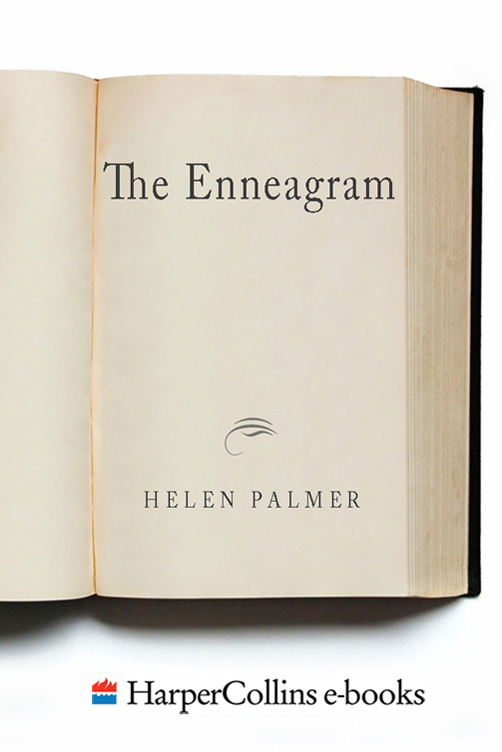Empirical study of the Enneagram typology has recently begun, based on published descriptions of the Enneagram theory. Studies in this area are useful to the degree that research findings integrate Enneagram theory with Western concepts of personality. Current research focuses on the stability of the individual persons Enneagram point over time and the relation of Enneagram type to other theories of personality. Also, researchers are developing personality assessment instruments that may reliably and validly predict Enneagram type.
Initial Research on the Enneagram
A first research program, reported by Wagner and Walker, examined 390 adults who knew the Enneagram system. Most of the subjects were members of various Roman Catholic religious congregations in the Midwest.
To assess the stability of Enneagram type over time, subjects were contacted and asked to report their original and current self-determined Enneagram point. The time lapse from initial learning of the Enneagram until the survey was conducted ranged from three months to nine years. The respondents averaged 85 percent agreement about their type in the past and present.
These subjects also completed the Myers-Briggs Type Indicator (MBTI), Millon-Illinois Self-Report Scale, and an experimental Enneagram inventory at varying times before, during, and after learning the Enneagram. The MBTI, based on Jungian personality types, is designed to assess patterns of attitudes, assumptions, and actions on the personality dimensions of introversion-extraversion, thought-feeling, sensingintuition, and judgment-perception.
Wagner found significant differences among Enneagram point groups on the Myers-Briggs and Millon scales, with patterns of descriptors summarized by him as follows:
Table 1. Comparison of Positive Correlations Among Enneagram Styles, Millon Personality Patterns, and Myers-Briggs Preferences (from Wagner and Walker, 1983)
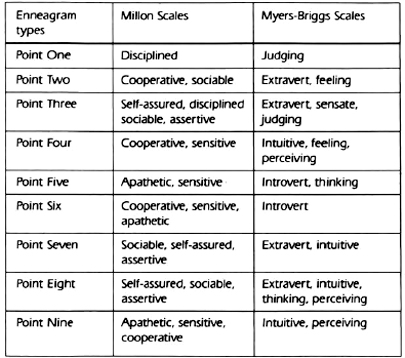
Also administered to subjects was Wagners Enneagram Personality Inventory, consisting of 135 items (15 for each type). Subjects indicated a degree of agreement or disagreement. In two administrations of the inventory, before and after training, Wagner found that Enneagram type was significantly associated with scores on the inventory. Wagners findings suggest that the objective test can predict type with a greater-than-chance accuracy and that learning the Enneagram theory increased the predictive validity of the test.
Wagners study contributes to the delineation of Enneagram theory by evaluating the typology against two other typological approaches in a relatively large sample. Also, his efforts to develop an objective assessment of Enneagram type should promote study leading to the determination of the reliability and generalizability of type, description and distinction of types, and prediction of type in a simplified, valid
Our Current Research Program
We have also conducted research on 172 volunteer subjects who are adult students of the Center for the Investigation and Training of Intuition. At the time of the assessment, all subjects had determined their Enneagram type from one month to several years prior to testing, with 47 percent being aware of their type for one year or less. Enneagram group size ranged from ten subjects identified as point Three to thirty-five subjects identified as point Nine. Cross-tabulations indicated that there were no significant associations in our sample between knowledge of the Enneagram, sex, professional status, and Enneagram type.
To assess personality differences among Enneagram types, we selected the MBTI (as had Wagner) and the Minnesota Multiphasic Personality Inventory (MMPI). The MMPI is the most widely researched personality index, but has not been previously studied in relation to the Enneagram. The ten clinical scales of the MMPI assess major categories of abnormal behavior, including hypochondriasis, depression, hysteria, psychopathic deviation, gender identification, paranoia, obsessiveness and compulsivity, schizophrenia, hypomania, and social introversion. Further, the MMPI provides for an assessment of test-taking attitudes, such as consistency, social desirability, and faking pathology.
We also developed an inventory of the Enneagram typology for this research program, the Cohen-Palmer Enneagram Inventory (CPEI). The CPEI is a compilation of statements of behavioral tendencies for each Enneagram point group. The CPEI totals 108 items, with twelve items in each of nine imbedded scales. Dichotomized responses to the descriptive statements are demanded, i.e., like me or not like me. We hypothesized that the highest scale score would predict the Enneagram type of the subject (which had been determined prior to administration of the inventory).
Results: MMPI
Using one-way analyses of variance and post hoc comparisons, we found significant differences among Enneagram groups on four of the clinical scales of the MMPI: depression, psychopathic deviation, psychasthenia (obsession-compulsion), and social introversion. The average group scores for each group are presented in Figure 1.
As can be noted on the depression scale, Group Four demonstrated the highest average score and was significantly higher than group Seven or Group Three (p<.002). Group Three demonstrated the lowest average score, with groups Four, Five, Six, Nine, Two, One, and Eight scoring significantly higher than Group Three. This finding is reasonable, given the tendency of point Three to deny emotional responses and the tendency of point Four toward behavior descriptive to their title, Tragic Romantic.
The significant differences among groups on the scale of psychopathic deviation (p<.006) were found between Group Eight, with the highest mean score, and Groups Seven, Nine, and One. Group Seven had the lowest mean score, significantly lower than groups Two, Six, and Four. The underlying dimension of this scale is thought to be assertion, with energetic, enterprising, venturesome, and social as positive counterpart behaviors, and hostile, manipulative, impulsive, and antisocial as negative counterpart behaviors.plausible, given the tendency of point Eight to be highly assertive and the tendency of point Seven to maintain social acceptability.
Figure 1. Average MMPI T-Scores of Enneagram Point Groups
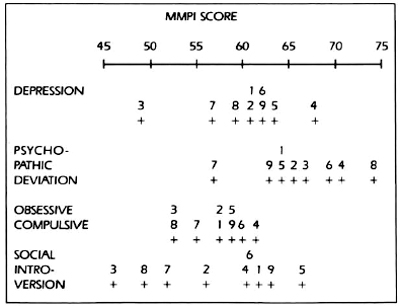
Significant group differences (p<.03) were also found on the psychasthenia (obsessive-compulsive) scale. This scale is thought to reflect anxiety, usually of a long-term nature Group Four demonstrated the highest mean score and differed significantly from Groups Three and Eight. Group Three had the lowest mean score and differed significantly from Groups Four, Five, and Six. These findings might suggest a relative tendency toward ritualistic behavior among point Four types and a greater tendency among point Three types to be flexible in behavior. Both concepts are coincident with chief features of these Enneagram points.
Highly significant differences were found on the scale of social introversion (p<.0000), with Group Five demonstrating the highest average score and differing significantly from Groups Three, Eight, Seven, Two, and Six. Group Three scored the lowest average score and was significantly lower than Groups Two, Six, Four, One, Nine, and Five. The items of this scale are concerned with uneasiness in social situations, insecurities, worries, and lack of social participation. The higher the scale, the more the person prefers solitude; the lower the scale, the more the individual seeks social contact. The underlying normal dimension assessed on the social introversion scale is posited to be autonomy.



